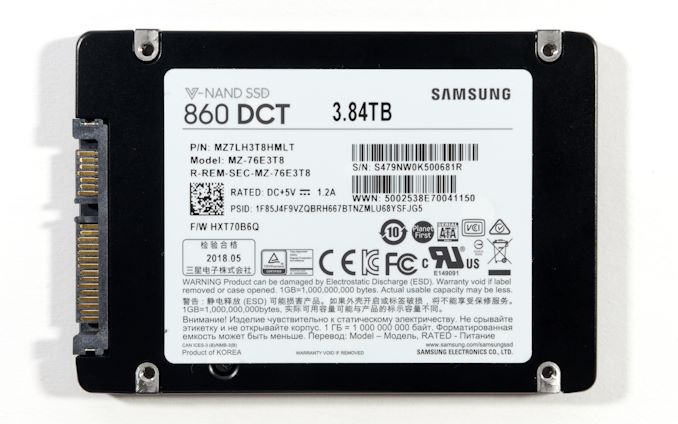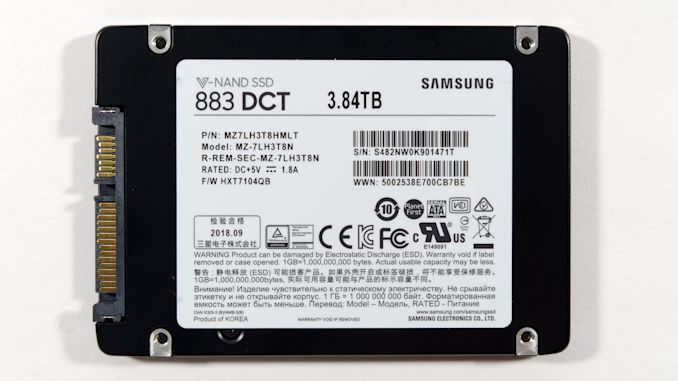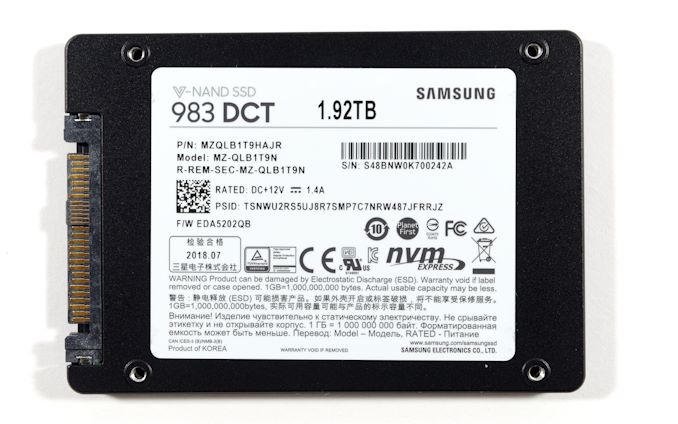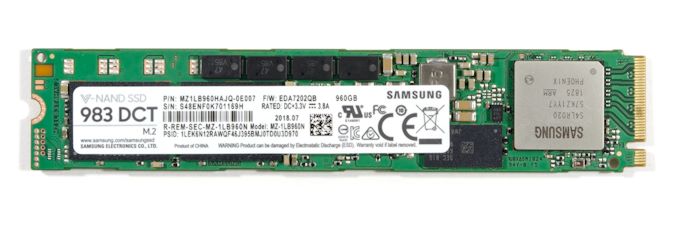The Enterpise TLC Storage Era Begins: Rounding Up 13 SSDs With Samsung, Intel, and Memblaze
by Billy Tallis on January 3, 2019 9:45 AM ESTSamsung's Latest Datacenter SSDs
In the latter half of this year, Samsung launched several new enterprise/datacenter SSD product lines. This is part of a new strategy to make its enterprise storage products more accessible to smaller customers. The 860 DCT, 883 DCT, 983 DCT and 983 ZET all use hardware that Samsung was already selling under different names, but are now being sold by retailers in individual quantities. We'll be testing the 983 ZET next month, but the other three new models have already survived our testing.
Samsung 860 DCT
The Samsung 860 DCT uses the same hardware as the 860 EVO consumer SSD, but with enterprise-oriented firmware. That means SLC caching is out and the firmware is optimized to provide consistent sustained performance, even though that means peak write speeds are far lower and the usable capacity is 4% lower due to increased overprovisioning. The 860 DCT also doesn't offer the idle power saving modes that consumer drives feature. The 860 DCT is an entry-level server drive that lacks many features traditionally associated with enterprise SSDs, most notably power loss protection capacitors. Like consumer SSDs, the 860 DCT operates with a volatile write cache, though this can be disabled at further cost to write performance.
| Samsung 860 DCT Specifications | ||||
| Capacity | 960 GB | 1.92 TB | 3.84 TB | |
| Controller | Samsung MJX | |||
| Form Factor | 2.5" 7mm SATA | |||
| NAND Flash | Samsung 64-layer 3D TLC | |||
| DRAM | 1 GB LPDDR4 | 2 GB LPDDR4 | 4 GB LPDDR4 | |
| Sequential Read | 550 MB/s | |||
| Sequential Write | 520 MB/s | |||
| Random Read | 98k IOPS | |||
| Random Write | 19k IOPS | |||
| Power Consumption | Read | 1.9 W | ||
| Write | 2.9 W | |||
| Idle | 1.05 W | |||
| Write Endurance | 349 TB 0.2 DWPD |
698 TB 0.2 DWPD |
1396 TB 0.2 DWPD |
|
| Warranty | 5 years | |||
The 860 DCT is intended for use primarily on very read-heavy workloads, with a very low volume of writes that preferably would be mostly sequential – for example, serving up streaming video. This is reflected by the write endurance rating of just 0.2 drive writes per day. Samsung doesn't intend for the 860 DCT to compete against any of their existing enterprise SSDs. Instead, they are targeting use cases where customers are currently using consumer-grade SSDs or mechanical hard drives.
This is pretty much the same description that everyone is giving for their first enterprise QLC SSDs, but the 860 DCT is still a TLC-based drive at this point. We expect its successor to switch to QLC NAND. Samsung says their currrent MJX controller can support 8TB SSDs, but so far they haven't gone beyond 4TB. As NAND and DRAM prices will continue to decline in 2019, it probably won't be long before they decide to max out the MJX controller.
The labeling on the 860 DCT differs slightly from Samsung's retail consumer SSDs, but inside we find exactly the same PCB, with components that differ only in date codes and lot numbers. Our 3.84 TB 860 DCT sample uses eight NAND packages each containing eight of Samsung's 512Gb 64-layer 3D TLC V-NAND, for a total raw capacity of 4 TiB.
Samsung 883 DCT
The Samsung 883 DCT is a more traditional enterprise SATA SSD, with the power loss protection capacitors that the 860 DCT lacks. The controller and NAND are still the same as in the 860 DCT and consumer 860 EVO. Random write performance is a bit better than the 860 DCT and the write endurance rating jumps up to 0.8 DWPD, a fairly mainstream value for enterprise drives intended to be used with read-heavy workloads.
The 883 DCT product line extends all the way down to 240GB where the 860 DCT family starts at 960GB. Samsung didn't sample the two smallest capacities of 883 DCT, but they are most likely to be used in applications that aren't performance-critical, such as OS boot drives. Samsung uses their smaller 256Gb TLC dies on the 960GB and smaller models, while the 1.92TB and 3.84TB models use the 512Gb TLC dies.
| Samsung 883 DCT Specifications | ||||||
| Capacity | 240 GB | 480 GB | 960 GB | 1.92 TB | 3.84 TB | |
| Controller | Samsung MJX | |||||
| Form Factor | 2.5" 7mm SATA | |||||
| NAND Flash | Samsung 256Gbit 64L 3D TLC | Samsung 512Gbit 64L 3D TLC | ||||
| DRAM | 512 MB LPDDR4 | 1 GB LPDDR4 | 2 GB LPDDR4 | 4 GB LPDDR4 | ||
| Sequential Read | 550 MB/s | |||||
| Sequential Write | 520 MB/s | |||||
| Random Read | 98k IOPS | |||||
| Random Write | 14k IOPS | 24k IOPS | 25k IOPS | 25k IOPS | 28k IOPS | |
| Power Consumption | Read | 3.6 W | ||||
| Write | 2.3 W | |||||
| Idle | 1.3 W | |||||
| Write Endurance | 341 TB 0.8 DWPD |
683 TB 0.8 DWPD |
1366 TB 0.8 DWPD |
2733 TB 0.8 DWPD |
5466 TB 0.8 DWPD |
|
| Warranty | 5 years | |||||
The addition of power loss protection capacitors doesn't require Samsung to adopt a larger PCB than the 860 DCT/860 EVO hardware, but it does give a more crowded layout. The 3.84 TB 883 DCT only has six large surface-mount capacitors plus empty pads on the back for two more, but there are enough other small components added that the large NAND, DRAM and controller packages had to be rearranged.
Samsung 983 DCT
The Samsung 983 DCT is an entry-level enterprise NVMe SSD. It has the same 0.8 drive writes per day endurance rating as the 883 DCT SATA drive, but boasts much higher performance. The 983 DCT uses the Samsung Phoenix controller that we are familiar with from the consumer 970 EVO and 970 PRO, and the OEM client PM981 SSDs. As usual, SLC caching is not implemented on the enterprise products, so write performance is substantially lower than what the consumer 970 EVO advertises, but read performance is similar.
The 983 DCT is only currently offered in two capacities: 960 GB and 1920GB, but customers also have their choice of M.2 or 2.5" U.2 form factors.
| Samsung 983 DCT Specifications | ||||||
| Capacity | 960 GB | 1.92 TB | 960 GB | 1.92 TB | ||
| Controller | Samsung Phoenix | |||||
| Form Factor | 2.5" 7mm U.2 | M.2 22110 | ||||
| Interface, Protocol | PCIe 3.0 x4 NVMe 1.2b | |||||
| NAND Flash | Samsung 256Gbit 64L 3D TLC | |||||
| DRAM | 1.5 GB LPDDR4 | 3 GB LPDDR4 | 1.5 GB LPDDR4 | 3 GB LPDDR4 | ||
| Sequential Read | 3000 MB/s | |||||
| Sequential Write | 1050 MB/s | 1900 MB/s | 1100 MB/s | 1400 MB/s | ||
| Random Read | 400k IOPS | 540k IOPS | 400k IOPS | 480k IOPS | ||
| Random Write | 40k IOPS | 50k IOPS | 38k IOPS | 42k IOPS | ||
| Power Consumption | Read | 8.7 W | 7.6 W | |||
| Write | 10.6 W | 8.0 W | ||||
| Idle | 4.0 W | 2.6 W | ||||
| Write Endurance | 1366 TB 0.8 DWPD |
2733 TB 0.8 DWPD |
1366 TB 0.8 DWPD |
2733 TB 0.8 DWPD |
||
| Warranty | 5 years | |||||
The M.2 version of the 983 DCT is rated to use significantly less power than the U.2 version. The 1.92 TB model is the only one that appears to have its performance meaningfully constrained by this, with sequential write speeds of 1.4GB/s instead of 1.9GB/s, and reduced random read and write performance.
The 983 DCT M.2 uses the 22x110mm card size, longer than the consumer standard of 80mm in order to accommodate the power loss protection capacitors. The 983 DCT M.2 is also double-sided, because unlike the 970 EVO it doesn't need to squeeze into thin laptops. This allows Samsung to use four NAND packages instead of two, and consequently shorter stacks of NAND dies.
The 2.5" version of the 983 DCT uses the same 7mm thick form factor as most SATA SSDs, but the construction is a bit different from Samsung's SATA drives: the screws holding the case together enter from the top instead of the bottom, and are covered by a label that puts Samsung's logo upside down relative to their SATA drives.
Inside, we find a PCB that uses almost all of the available space, with more than twice as many power loss protection capacitors as on the M.2 version. To keep all eight channels of the Phoenix controller busy and maximize performance, Samsung uses their 256Gb TLC dies on both capacities. The 983 DCT also features 50% more DRAM per GB of NAND than is common for SATA drives; some of this extra may be used for more robust ECC, but the primary purpose is most likely enabling higher performance.































36 Comments
View All Comments
FunBunny2 - Thursday, January 3, 2019 - link
"The rack is currently installed in an unheated attic and it's the middle of winter, so this setup provided a reasonable approximation of a well-cooled datacenter."well... I don't know where your attic is, but mine is in New England, and the temperature hasn't been above freezing for an entire day for some time. what's the standard ambient for a datacenter?
Ryan Smith - Thursday, January 3, 2019 - link
It is thankfully much warmer in North Carolina.=)Billy Tallis - Thursday, January 3, 2019 - link
I"m in North Carolina, so the attic never gets anywhere close to freezing, but it was well below normal room temperature during most of this testing. Datacenters aren't necessarily chilled that low unless they're in cold climates or are adjacent to a river full of cold water, but servers in a datacenter also tend to have their fans set to run much louder than I want in my home office.The Intel server used for this testing is rated for continuous operation at 35ºC ambient. It's rated for short term operation at higher temperatures (40ºC for 900 hours per year, 45ºC for 90 hours per year) with some performance impact but no harm to reliability. In practice, by the time the air intake temperature gets up to 35ºC, it's painfully loud.
Jezzah88 - Friday, January 4, 2019 - link
16-19 depending on sizedrajitshnew - Thursday, January 3, 2019 - link
It enough information available for you to at least make a pipeline post clarifies the differences between Z-Nand (Samsung) and traditional MLC/SLC flashBilly Tallis - Thursday, January 3, 2019 - link
I should have a review up of the Samsung 983 ZET Z-SSD next month. I'll include all the information we have about how Z-NAND differs from conventional planar and 3D SLC. Samsung did finally share some real numbers at ISSCC2018, and it looks like the biggest difference enabling lower latency is much smaller page sizes.MrCommunistGen - Thursday, January 3, 2019 - link
Very much looking forward to the review!Greg100 - Thursday, January 3, 2019 - link
It's a pity that we don't have consumer drives that are fast and at the same time have large enough capacity - 8TB. I would like to have a consumer U.2 drive that has 8TB capacity.What we have now… only 4TB Samsung and… SATA :(
Will Intel DC P4510 8TB be compatible with Z390 motherboard, Intel Core i9-9900K and Windows 10 Pro? Connection via U.2 to M.2 cable (Intel J15713-001). Of course the M.2 port on the motherboard will be compatible with NVMe and PCI-E 3.0 x4.
I know that compatibility should be checked on the motherboard manufacturer's website, but nobody has checked Intel DC P4510 drives and nobody will, because everyone assumes that the consumer does not need 8TB SSDs.
Anandtech should also do tests these drives on consumer motherboards. Am I the only one who would like to use Intel DC P4510 8TB with Intel Z390, Intel Core i9-9900K and Windows 10 Pro? Is it possible? Will there be any compatibility problems?
Billy Tallis - Thursday, January 3, 2019 - link
I don't currently have the necessary adapter cables to connect a U.2 drive to our consumer testbed, but I will run the M.2 983 DCT through the consumer test suite at some point. I have plenty of consumer drives to be testing this month, though.Generally, I don't expect enterprise TLC drives to be that great for consumer workloads, due to the lack of SLC caching. And they'll definitely lose out on power efficiency when testing them at low queue depths. There shouldn't be any compatibility issues using enterprise drives on consumer systems, though. There's no need for separate NVMe drivers or anything like that. Some enterprise NVMe drives do add a lot to boot times.
Greg100 - Thursday, January 3, 2019 - link
Thank you :-) So I will try that configuration.Maybe Intel DC P4510 8TB will not be the boot champion or power efficiency drive at low queue depths, but having 8TB data on a single drive with fast sequential access have huge benefits for me.
Do you think it is worth waiting for 20TB Intel QLC or 8TB+ client drives? Any rumors?